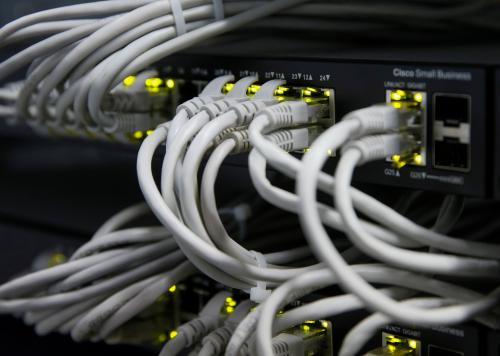After four years of “unbuilding” by the Trump FCC, the new Biden Federal Communications Commission (FCC) faces significant challenges to Build Back Better. This is one of a series of blog posts addressing a selection of those challenges.
The internet is the most powerful and pervasive platform in the history of the planet. A huge amount of that power comes from its ubiquitous wireless extension. From the beginning of time, communications commanded the user to come to the message; for the last several decades that equation has been reversed. The wireless revolution put users in control to command the information to come to them wherever they may be.
The pathway for such ubiquity is the electromagnetic spectrum, the airwaves that carry the wireless signals to wherever they may be most productively consumed. The federal government oversees allocation of those precious pathways. The Trump administration engaged in high profile presidential performances about the importance of spectrum policy, but it failed to establish a coordinated national plan. The result left the Federal Communications Commission (FCC) enmeshed in needless squabbles and unnecessary delays.
An Absence of Planning
Before taking office Donald Trump reportedly spent little time considering the massive responsibilities of managing the federal government. According to Michael Lewis’ book “The Fifth Risk”, Trump told former New Jersey governor Chris Christie, who was heading the presidential transition effort, “You and I are so smart we can leave the victory party two hours early and do the transition ourselves.” Trump subsequently fired Christie and the transition floundered.
This lack of preparation ricocheted throughout the government post-inauguration. One of the casualties was a coherent national spectrum policy. For its entire tenure, the Trump administration had no overall plan for the radio frequency spectrum so important to the internet and the key to fifth generation (5G) wireless technology.
Donald Trump left office having made big statements about 5G and the importance of spectrum, but without a strategy to achieve those goals.
On October 25, 2018—21 months into his term—President Trump issued a Presidential Memorandum on Developing a Sustainable Spectrum Strategy for America’s Future. It was an indictment of the previous failure to plan and act. The Memorandum—an admission that there was no spectrum plan—gave the National Telecommunications and Information Administration (NTIA) in the Department of Commerce 270 days to develop “a long-term National Spectrum Strategy.”
The promised national spectrum plan was never delivered.
Donald Trump left office having made big statements about 5G and the importance of spectrum, but without a strategy to achieve those goals. Absent leadership from the top, government agencies fought to protect parochial interests and the deployment of 5G spectrum was delayed.
Creating Federal Spectrum Policy
Multiple federal agencies have a piece of the nation’s spectrum policy. At the pinnacle is the White House. As with so many other realities that Donald Trump did not appreciate when he said he could organize the federal government in hours, being the nation’s chief executive meant refereeing among competing demands to determine the national purpose and a policy to implement that purpose on disparate issues—including spectrum.
At the operational level, the oversight of spectrum is divided between NTIA, which is responsible for federal government spectrum, and the FCC, which has authority over non-government spectrum. It is the job of NTIA to adjudicate the competing federal government interests in accord with the national spectrum policy. The FCC fulfills the same role to put non-governmental spectrum to its highest and best use and to assign it among various users, both licensed and unlicensed, commercial and non-commercial.
By law, the FCC and NTIA are required to coordinate their respective activities. The two agencies formally meet every six months to resolve issues and planning. Their relationship is governed by a 2003 Memorandum of Understanding on Spectrum Coordination.
Because of the lack of transition planning, NTIA was without an Administrator (who is also an Assistant Secretary of Commerce) for most of the first year of the Trump administration. It was not until December 2017 that David Redl, a highly qualified congressional staff member, assumed the position. The policy vacuum created by the almost one-year delay became an opportunity for those seeking to advantage their own spectrum position.
After only 17 months on the job, trying to be the rational spectrum adjudicator in the absence of a national policy, Redl resigned in May 2019 rather than be fired. A hallmark of his tenure had been a running battle over spectrum policy which came to a head in a speech he made three days before his resignation in which he discussed the “false choices” that were being advanced in the absence of a coordinated policy.
At a time when there was a crucially important need for executive leadership on spectrum policy, the principal policy adviser on spectrum issues was pushed out. In the 20 months remaining in the Trump administration NTIA was a revolving door of replacements, including four acting administrators who shuffled through the agency. None of them had the spectrum knowledge and policy experience of the dismissed David Redl.
When Policy Processes Reigned
In contrast to the Trump chaos, the Obama administration’s transition focused on the need for spectrum policy. As a result, the administration began with a special team at the FCC charged with creating a national broadband plan. On June 28, 2010, 17 months into his term, President Obama issued instructions to implement a spectrum policy in accord with the recommendations of that plan.
President Obama’s 2010 Presidential Memorandum “Unleashing the Wireless Broadband Revolution” ordered that the United States double the amount of commercial spectrum available and put it to use for wireless broadband. Unlike President Trump’s open-ended (and never realized) “come back with a plan,” President Obama ordered 500 MHz of spectrum to be made available for commercial mobile and fixed broadband use. The Presidential Memorandum sent the message to all federal agencies that they were to facilitate the new—numerically specific—national policy.
When I was FCC Chairman in the second Obama term, we were in the advantageous position of working with other federal agencies—notably the Defense Department, the largest federal spectrum user—that had already been told by the president to facilitate spectrum reallocation. No one likes to part with the spectrum they have grown accustomed to using, but the job was made easier (on both sides) by the Commander-in-Chief’s directive.
A Lost Year in the “Race to 5G”
The “sweet spot” for 5G spectrum is in the so-called spectrum mid-band, an area between 2 and 6 GHz on the frequency chart. Of particular interest was the spectrum between 3 and 4 GHz that had been internationally harmonized for 5G.
As a result of the negotiation with the Defense Department, the Obama FCC was able to reallocate for commercial usage 145 MHz of mid-band spectrum (3.55 to 3.7 GHz) for both licensed and unlicensed 5G. The Trump FCC then ran an auction for its commercial licensing.
The biggest part of the sweet spot spectrum is called C-band, the 500 MHz of airwaves between 3.7 and 4.2 GHz. The Trump FCC first proposed using C-band for 5G In July 2018, 18 months after taking office. Eleven months later, in April 2019, President Trump declared with typical bravura, “The race to 5G is on and America must win.” He then promised, “my administration is freeing up as much wireless spectrum as needed.”
By the time Donald Trump finally called FCC Chairman Pai in October 2019 to get him back on track, the United States had lost at least a year in the spectrum race “America must win.”
But the Trump FCC—almost two-and-one-half-years after taking office—had not been “freeing up” C-band spectrum. The principal cause of this wasted time was the Trump FCC’s effort to outsource their spectrum responsibilities to industry. Under this plan—a mix of Republican anti-government orthodoxy and corporate opportunism—the satellite companies, whose licenses would be repurposed for terrestrial use, would assume the FCC’s spectrum assignment role. Authorized to run a private auction of spectrum they did not own, the licensees could enjoy windfall profits in lieu of auction revenues going to the U.S. Treasury. In typical Orwellian spin, the Trump FCC announced it would be “faster” if the licensees took over the job the agency is statutorily empowered to perform.
By the time Donald Trump finally called FCC Chairman Pai in October 2019 to get him back on track, the United States had lost at least a year in the spectrum race “America must win.” The auction finally began in December 2020 and did not end until February 17th, 2021—after the Trump administration left office. The effect of the Trump FCC’s anti-government dalliance meant that entering the “race to 5G” had taken at least a year longer than it should have taken if the Trump FCC had simply stepped up and done its job.
Agency Squabbles
Part One
C-band is not the only spectrum that could help facilitate 5G. Putting other pieces of spectrum to work without guidance from the White House, however, triggered interdepartmental turf wars.
As the Trump FCC took over, work was well underway on allowing the so-called “L-band” spectrum at 1.5 GHz to be used for mobile network purposes. This band of approximately 40 MHz also increased in importance as the demand for 5G spectrum increased. The void in spectrum planning by the Trump administration, however, turned this piece of prime spectrum real estate into a battlefield.
The L-band spectrum is located next to spectrum assigned to GPS services. An early Obama FCC attempt to reassign the L-band for terrestrial mobile service fell apart because some GPS receivers were inadequately filtered and could pick up the next-door L-band signal, even though it was outside their licensed area of operation. To address GPS interference concerns, the company holding usage rights to the spectrum (Ligado) revised its plans to give up usage of 10 MHz, reduce the power on another 10 MHz, and pay to retrofit GPS equipment. Engineering studies by the FCC showed these efforts mitigated the previous worries.
The new Trump team—whether at the Defense Department, NTIA or FCC—walked into this debate hampered by the absence of transition planning and the slowness of filling key positions. The representatives of the GPS community used this vacuum to reopen their complaints about terrestrial use of the L-band. Not surprisingly, the new team at DOD, in the absence of a national policy, defined their responsibility myopically in defense of GPS and led the charge against L-band deployment.
Normally, such a dispute would be worked out in the interagency process at NTIA. The lack of a spectrum compass within the Trump administration turned the discussion into a donnybrook. When Assistant Secretary Redl (whose congressional experience had well-acquainted him with the issues in the debate) finally arrived, the lobbying was in full swing.
Despite the upheaval within the administration, the Trump FCC—over the objections of the Secretary of Defense—ended up doing the right thing on its own initiative and opened L-band for 5G usage. As a last gasp, the GPS industry ran to Congress to complain. Once again making L-band available was delayed; the 2021 National Defense Authorization Act forbade the Secretary of Defense from expending funds to comply with the FCC Order until completion of a study by the National Academy of Science (NAS) to “evaluate the potential harmful interference concerns” related to GPS.
To the Biden FCC now falls the responsibility of dealing with the issue following the NAS report scheduled for release in the fall of 2021.
Part Two
Interestingly, the same Defense Department that had been complaining that GPS and 5G on L-band could not coexist ended up in the last days of the Trump administration proposing that it share some of its other spectrum with commercial providers but avoid the FCC. The DOD proposed—and even issued a Request for Information—that the department lease some of its government spectrum for commercial purposes and keep the proceeds.
The new Department of Defense (DOD) proposal was to bypass the long-existing statutory framework that the FCC had jurisdiction over commercial spectrum and NTIA had jurisdiction over government spectrum to anoint the department as a new provider and regulator of spectrum for commercial purposes. Under its plan, the 5G spectrum would remain under DOD control, but be used by commercial wireless providers and the department would keep the proceeds.
That such a proposal was possible was the consequence of a lack of a national plan for spectrum usage. The DOD proposal remains in existence today and will be yet another spectrum issue for the Biden administration and the Biden FCC to solve.
Part Three
To add to the spectrum confusion left behind by the Trump administration, a large piece (100 MHz, from 3.45 to 3.55 GHz) of the spectrum the DOD intended to monetize for itself was simultaneously scheduled for auction by the Trump FCC. This action was taken at the same time the DOD was proposing to usurp the FCC’s role.
When the Biden FCC took over, interim Chairperson Jessica Rosenworcel announced that the agency would issue rules in March for an October 2021 auction of this spectrum.
Part Four
For years there has been a running dispute between the Department of Transportation and others about the spectrum at 5.9 GHz. That commercial spectrum was assigned decades ago by the FCC for Dedicated Short-Range Communications (DSRC) to facilitate intelligent transportation systems (ITS) and smart vehicles.
Less than two weeks after Donald Trump lost the presidential election, the Trump FCC voted over the objections of the Department of Transportation to reassign pieces of the ITS spectrum. In this reassignment 45 MHz (5.85 to 5.895 GHz) was made available for unlicensed use such as WiFi, and 45 MHz (in 5.895 to 5.925 GHz) for new intelligent vehicle technology called Cellular Vehicle-to-Everything (C-V2X). The vote was a bipartisan 5-0, including the vote of the Commissioner who became the Biden FCC’s Interim Chairwoman, Jessica Rosenworcel.
The disputes over the ITS spectrum have been running for decades and do not appear to be finished, despite the FCC’s November decision.
Towards a National Spectrum Policy
As a Commissioner during the Trump administration, the Biden FCC’s Acting Chairwoman called out the disarray resulting from the lack of a national spectrum policy. “We are heading into our wireless future with something less than a fully coordinated effort,” she warned.
The Biden administration has not repeated the failure to prepare with transition planning. “What we need to do is—and the president has been clear—is to step back and have a national strategy on spectrum, and look to make spectrum available from public and commercial uses,” the new Commerce Secretary, Gina Raimondo, told senators at her confirmation hearing. This is an especially important statement not only because she referenced the president’s commitment, but also because NTIA, the focus of such efforts, is within her department.
The responsibility of governing is a job of making decisions. The failure of the Trump administration to decide among various priorities to establish a national spectrum policy has left the nation rudderless. It now falls to the Biden administration to place a firm hand on the rudder and guide the nation into the spectrum-based future of communications.
The Brookings Institution is committed to quality, independence, and impact.
We are supported by a diverse array of funders. In line with our values and policies, each Brookings publication represents the sole views of its author(s).








Commentary
Spectrum: The pathway of the 21st century
Part 5 of Build Back Better with Biden FCC
March 12, 2021